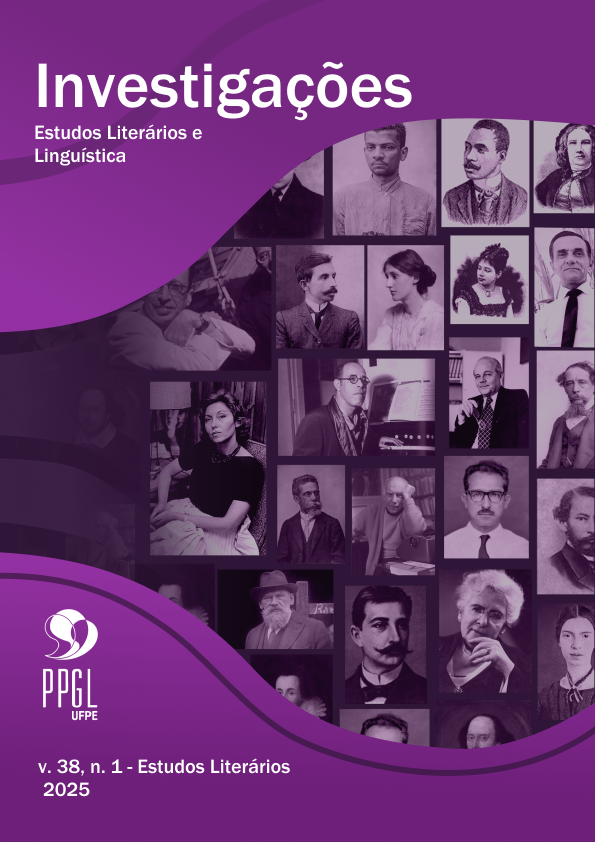Translating the sacred: a reading of H. A. Murena's poetry in the light of the Sophia Perennis
DOI:
https://doi.org/10.51359/2175-294x.2025.265104Keywords:
H. A. Murena, perennial philosophy, sacred, poetry, artAbstract
This paper aims to study the poetics of the sacred on which the lyrical work of the Argentinean writer Héctor Álvarez Murena (1923-1975) is based and to establish the keys to reading his poetry from the foundations of Perennialism (whose greatest exponent is René Guénon), a tendency that defends the existence of a ‘Primordial Tradition’, the root of all religions and initiatic traditions. Our interest is, therefore, focused on the final stage of his intellectual and literary career, in which the writer shows a greater inclination towards questions of a metaphysical, sacred and esoteric nature.
References
BAUDELAIRE, Charles. Lo cómico y la caricatura y El pintor de la vida moderna. Traducción de Carmen Santos. Madrid: La balsa de Medusa, 2015.
BORELLA, Jean. René Guénon y la escuela tradicional. In: FAIVRE, Antoine ; NEEDLEMAN, Jacob (org.). Espiritualidad de los movimientos esotéricos modernos. Barcelona, Paidós, 2000, p. 435-476.
BURCKHARDT, Titus. Principios y métodos del arte sagrado. Traducción de Esteve Serra. Palma de Mallorca: José J. de Olañeta, Editor, 2000.
BURCKHARDT, Titus. Alquimia: significado e imagen del mundo. Traducción de Ana María de la Fuente. Barcelona: Plaza & Janes, 1975.
CIRLOT, Juan Eduardo. Diccionario de símbolos. Madrid: Siruela, 2001.
COOMARASWAMY, Ananda K. The Dance of Shiva: Fourteen Indian Essays. Nueva Dehli: Munshiram Manoharlal, 1999.
ELIADE, Mircea. Herreros y alquimistas. Traducción de E.T. y Manuel Pérez Ledesma. Madrid: Alianza, 2016.
ELIOT, Thomas Stearns. Tradition and the Individual Talent. In: ELIOT, Thomas Stearns. The Waste Land and Other Writings. Nueva York: Modern Library, 2002, p. 99-108.
ESTEBAN, Patricia. La palabra imprecisa de Héctor A. Murena en los márgenes del ensayo argentino contemporáneo. 2008. Tesis (Doctorado en Literatura Hispanoamericana) – Facultad de Filología, Universidad Complutense de Madrid, Madrid, 2008.
GUÉNON, René. Símbolos fundamentales de la ciencia sagrada. Traducción de José Luis Tejada y Jeremías Lera. Barcelona: Paidós, 2018.
GUÉNON, René. La Gran Tríada. Traducción de Francesc Gutiérrez. Barcelona: Obelisco, 1986.
GUÉNON, René. El reino de la cantidad y los signos de los tiempos. Traducción de Ramón García Fernández. Barcelona: Paidós, 1997.
GUTIÉRREZ CASTRO, Juan José. H. A. Murena: el retorno de América. Cuadernos de Aleph, Valencia, v. 17, p. 43-58. https://doi.org/10.5281/zenodo.14882388
LAO ZI. Tao te king: libro del curso y la virtud. Traducción de Anne-Hélène Suárez Girard. Madrid: Siruela, 2007.
MATURO, Graciela. La poesía, un pensamiento auroral. Córdoba: Alción, 2014.
MERCADO, Javier. H. A. Murena, la recuperación de lo sagrado. Orbis Tertius, La Plata, v. 24, n. 29, p. 1-11, 2019.
MUJICA, Hugo. Más hondo. Antología poética (1983-2023). Madrid: Vaso Roto, 2023.
MURENA, Héctor A.; VOGELMANN, David J. El secreto claro (diálogos). Buenos Aires: Fraterna, 1978.
MURENA, Héctor A. Una corteza de paraíso: la poesía de H. A. Murena (1951-1979). Valencia: Pre-textos, 2018.
MURENA, Héctor A. Visiones de Babel. México: Fondo de Cultura Económica, 2002
MURENA, Héctor A. Ensayos sobre subversión. San Juan de Puerto Rico: La Torre, 1963.
MURENA, Héctor A. Homo atomicus. Buenos Aires: Sur, 1961.
NEGRONI, María. Prólogo. In: MURENA, Héctor A. Una corteza de paraíso: la poesía de H. A. Murena (1951-1979). Valencia, Pre-textos, 2018, p. 7-17.
OROZCO, Olga. Alrededor de la creación poética. In: OROZCO, Olga. Relámpagos de lo invisible. Buenos Aires: Fondo de Cultura Económica, 2009, p. 295-301.
OTTO, Rudolf. Lo santo: Lo racional y lo irracional en la idea de Dios. Traducción de Fernando Vela. Madrid: Alianza, 2005.
PAZ, Octavio. El arco y la lira. México: Fondo de Cultura Económica, 2010.
PORRINI, Sebastián. Los otros: la metafísica operativa en los siglos XX y XXI. Salamanca: Matrioska, 2020.
SEDGWICK, Mark. Guénonian Traditionalism in South American literature and academia. International Journal of Latin American Religions, São Paulo, v. 5, n. 1, 2021, p. 164-180.
SCHOLEM, Gershom. La Cábala y su simbolismo. Traducción de José Antonio Pardo. Madrid: Siglo XXI, 2021.
SEDLMAYR, Hans. El arte descentrado. Las artes plásticas de los siglos XIX y XX como síntoma y símbolo de la época. Traducción de Gabriel Ferraté. Barcelona: Labor, 1959.
ZAMBRANO, María. Filosofía y poesía. Madrid: Fondo de Cultura Económica, 2001.
ZOLLA, Elémire. Una introducción a la alquimia: Las maravillas de la naturaleza. Traducción de José María Pinto. Barcelona: Paidós, 2003.
ZOLLA, Elémire. Los arquetipos. Traducción de Esdras Parra. Caracas: Monte Ávila, 1983.
Downloads
Published
How to Cite
Issue
Section
License
Copyright (c) 2025 Juan José Gutiérrez Castro

This work is licensed under a Creative Commons Attribution 4.0 International License.
Authors who publish with Revista Investigações agree to the following terms:
Authors retain copyright and grant the journal right of first publication with the work simultaneously licensed under the Creative Commons Attribution 4.0 International (CC BY 4.0) license that allows others to share the work with an acknowledgement of the work's authorship and initial publication in this journal.
Authors are able to enter into separate, additional contractual arrangements for the non-exclusive distribution of the journal's published version of the work (e.g., post it to an institutional repository or publish it in a book), with an acknowledgement of its initial publication in this journal.
You are free to:
Share — copy and redistribute the material in any medium or format for any purpose, even commercially.
Adapt — remix, transform, and build upon the material for any purpose, even commercially.
The licensor cannot revoke these freedoms as long as you follow the license terms.
Under the following terms:
Attribution — You must give appropriate credit , provide a link to the license, and indicate if changes were made . You may do so in any reasonable manner, but not in any way that suggests the licensor endorses you or your use.
No additional restrictions — You may not apply legal terms or technological measures that legally restrict others from doing anything the license permits.

